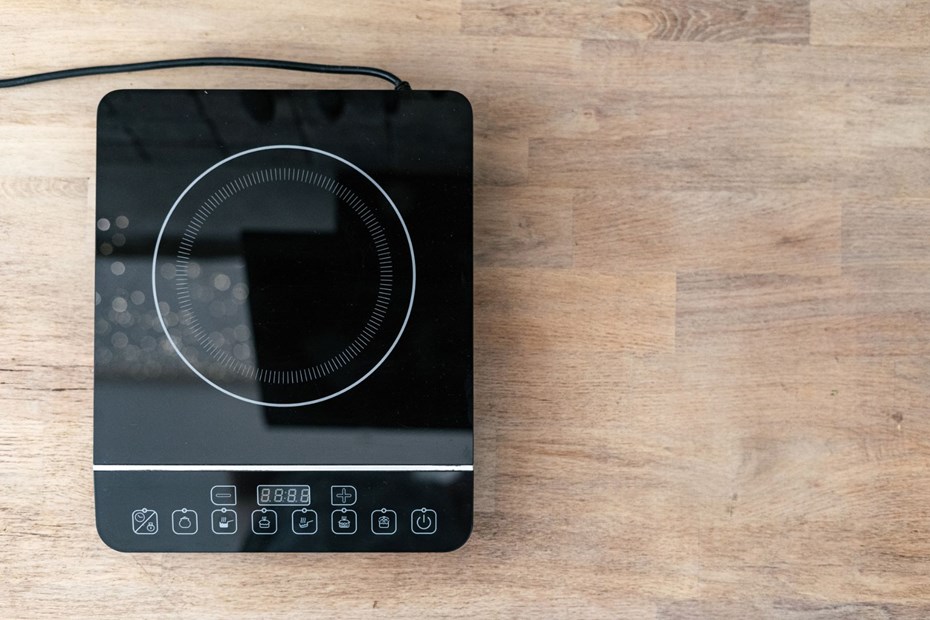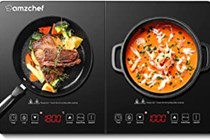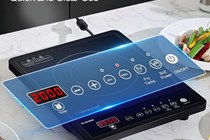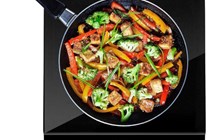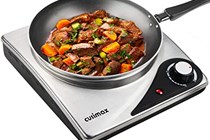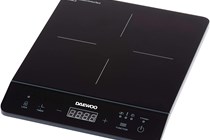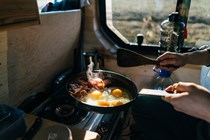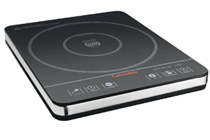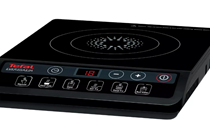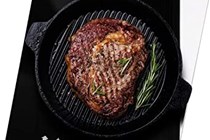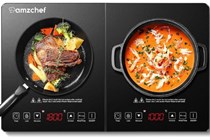When it comes to making those camping meals, once you’ve assembled your camping cookware you need a heat source – but have you ever thought about a camping induction hob? Now, gas is great, but it does have its downsides. In each tank, you only have a finite amount of fuel; storage takes up space, and those canisters can be costly. So, what’s the solution? Induction power. Let’s not pretend this doesn’t have some compromises – it’ll need electrical power to work, and you may have to buy new induction-compatible pots and pans to use on your portable camping induction hob.
Due to the design of camping induction hobs, they are best used by those in caravans, motorhomes and campervans with electrical hookups. The same goes for those campers in large trailer tents and family tents, who will also find a use for them or anyone with a pitch catered with a reasonable kitchen space. Rough and ready campers in one, two and three-person tents will want to stick to their gas stoves, campfire cooking or the local pub.
But before you get into the nitty-gritty, you need to see the best that camping induction hobs can offer. Getting the right equipment for camping is never a walk in the park, and getting stuff together comes with its challenges. Thankfully, here at Parkers, we can help improve your camping game with our roundup of the best portable induction cooking hobs
In this article, we’ve had a look at the best induction hobs out there for camping to ease the cooking dramas and make sure you have a full tummy and a happier time camping.
The best camping induction hobs at a glance
Editor’s choice: Deawoo Single Induction Hob – Buy now from Robert Dyas
Best for ease of use: Andrew James Single Induction Hob – Buy now from Amazon UK
Best for efficiency: Caterlite Induction Hob 2000W – Buy now from Nisbets
The best camping induction hobs
Editor's choice
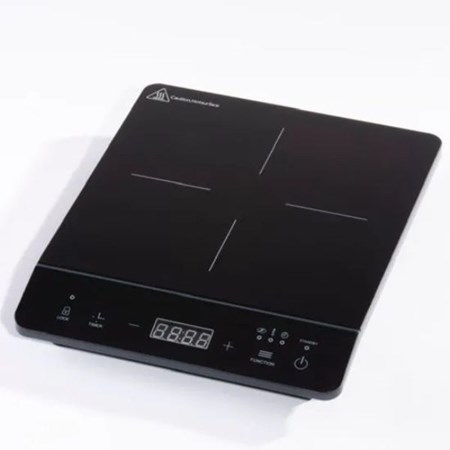

There are a number of handy features present to help a camp chef deliver a tasty feast, including timers and specific heat settings for frying, steaming and warming. For safety and longevity, there's also an auto-off function and overheat protection.
Pros
- Handy pre-set functions
- Cools quickly
Cons
- Not so good with smaller pans
Best for ease of use
Ten power temperature settings are available on an LED screen, with the lower settings using 200 watts and high temperatures pumping out 2,000 watts. This will give you a cooking range between 60°C and 240°C and is suitable for pan sizes from 12 to 22cm with an auto shut-off if no pan is detected on the hob.
Pros
- Timer function
- Lightweight
Cons
- Power adjustment could be more refined
Best build quality
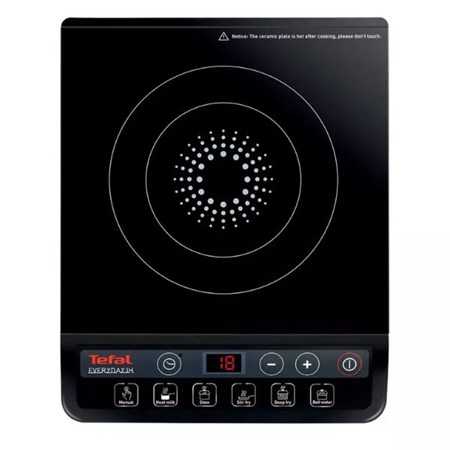

Easy to store with six different cooking functions available at the touch of a button, you can also control the hob's temperature and set a timer for cooking.
Pros
- Convenient to store
- Easy temperature control
Cons
- Fan can be noisy
Best dual hob
You can adjust the power or temperature of each hob independently hob, with the obvious benefit of two separate heat zones. With a digital countdown timer, which you can set for one minute or three hours, there is also a safety lock, high-temperature indicator and an Auto Safety Switch Off function.
Pros
- Two hobs
- Independent control
Cons
- Temperature adjustment increments are too large
Best for efficiency
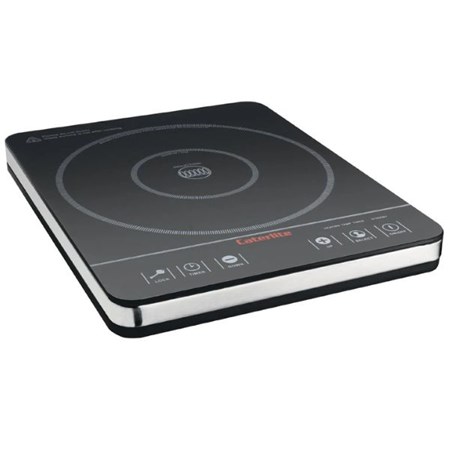

The hob features automatic pan detection, which means power is only applied when a pan is in position. This saves energy (vital when camping) and helps extend the induction hob's lifespan. It'll accommodate pans of up to 24cm and provides a temperature range from 60°C to 240°C.
Pros
- Overheat protection
- Auto shut-off timer
Cons
- The fan could be quieter
Why use an induction hob when camping?
Induction hobs are commonly found in home kitchens, but why bother taking one away with your camping? Well, there are many benefits to induction technology. They use around 70 per cent less power than standard electrical stoves, plus around 90 per cent of the heat created by the induction hob is transferred directly into the pan. They are also quick to clean, given that they have a perfectly smooth top.
But probably the best reason to use an induction hob when camping is for safety. Induction hobs are free from flames and the surface does not heat up in the same way as a standard electrical hot plate. When you’re camping or in a motorhome, reducing your reliance on flame and intense heat can only be a good thing.
Due to the way an induction hob works, which you can read more about at the bottom of this page, the stovetop also stays very cool throughout the cooking process – only the pan has heat. The induction hob will be warmed via its contact with the pan, but this will quickly dissipate once the pan is removed. This is perfect for anyone camping with young ones.
How does an induction hob work, and why do I need new pans?
An induction hob uses a copper coil to create a magnetic field, which, when coupled with a magnetic pan, creates heat. It’s a super-efficient way of cooking, leveraging physics to create heat using much less power than alternative traditional methods.
There’s a good chance that when you move to induction cooking, you’ll need to get some new pans. This is because the pan needs to be magnetic otherwise, it won’t get warm. Many pans aren’t magnetic, so you’ll have to double-check before purchase.
If you want to use induction hobs in your family tent or motorhome, you can probably make the space for a normal-sized saucepan and frying pan. An option like this Morphy Richards Induction Five Piece Set (RRP £69.99) will provide you with all you need for outdoor camping induction cooking.
Myles Warwood is an Autos Products Writer for both Parkers and CAR, specialising in child seats and e-bikes. In his spare time, he’s a freelance cycling journalist and dog owner.
Sign up to the Parkers Newsletter to keep up to date with more of the latest reviews, news, and recommendations from the Parkers team.
Just so you know, whilst we may receive a commission or other compensation from the links on this website, we never allow this to influence product selections – read why you should trust us
Just so you know, we may receive a commission or other compensation from the links on this website - read why you should trust us.


